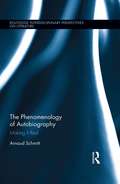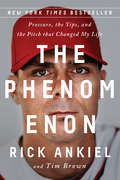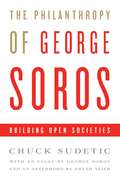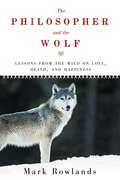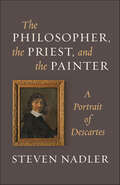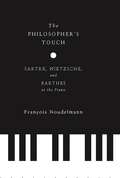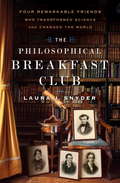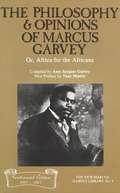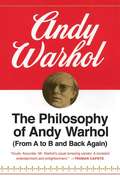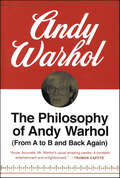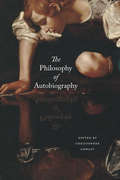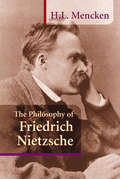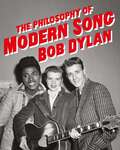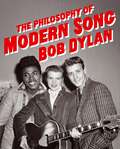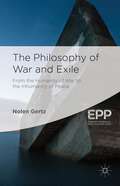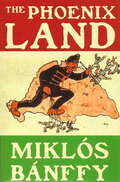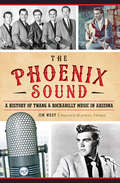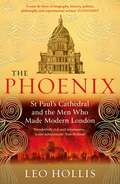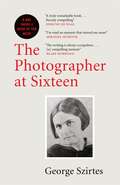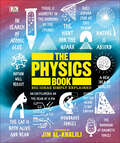- Table View
- List View
The Phenomenology of Autobiography: Making it Real (Routledge Interdisciplinary Perspectives on Literature)
by Arnaud SchmittTaking a fresh look at the state of autobiography as a genre, The Phenomenology of Autobiography: Making it Real takes a deep dive into the experience of the reader. Dr. Schmitt argues that current trends in the field of life writing have taken the focus away from the text and the initial purpose of autobiography as a means for the author to communicate with a reader and narrate an experience. The study puts autobiography back into a communicational context, and putting forth the notion that one of the reasons why life writing can so often be aesthetically unsatisfactory, or difficult to distinguish from novels, is because it should not be considered as a literary genre, but as a modality with radically different rules and means of evaluation. In other words, not only is autobiography radically different from fiction due to its referentiality, but, first and foremost, it should be read differently.
The Phenomenon: Pressure, The Yips, And The Pitch That Changed My Life
by Rick AnkielRick Ankiel had the talent to be one of the best pitchers ever. Then, one day, he lost it.The Phenomenon is the story of how St. Louis Cardinals prodigy Rick Ankiel lost his once-in-a-generation ability to pitch--not due to an injury or a bolt of lightning, but a mysterious anxiety condition widely known as "the Yips." It came without warning, in the middle of a playoff game, with millions of people watching. And it has never gone away.Yet the true test of Ankiel's character came not on the mound, but in the long days and nights that followed as he searched for a way to get back in the game. For four and a half years, he fought the Yips with every arrow in his quiver: psychotherapy, medication, deep-breathing exercises, self-help books, and, eventually, vodka. And then, after reconsidering his whole life at the age of twenty-five, Ankiel made an amazing turnaround: returning to the Major Leagues as a hitter and playing seven successful seasons.This book is an incredible story about a universal experience--pressure--and what happened when a person on the brink had to make a choice about who he was going to be.
The Philanthropy of George Soros: Building Open Societies
by Chuck Sudetic George SorosWith an Introduction by George Soros and an Afterword by Aryeh Neier George Soros is one of the world's leading philanthropists. Over the past thirty years, he has provided more than $8 billion to his worldwide network of foundations: the Open Society Foundations, which have applied the concept of the open society, the cornerstone of Soros's thinking on democracy, freedom, and human rights, in the United States and abroad. This book, written by formerNew York Times journalist Chuck Sudetic, marks the first exploration of George Soros's innovative philanthropic strategies and unmatched commitment to building open societies in places where dictatorship and violent repression have been the rule for too long. Soros is widely lauded for his brilliant financial and economic insights and investment strategies. But his philosophy-driven philanthropy and its impact are unprecedented for a private individual, and have produced remarkable results. Soros's visionary efforts include: helping to topple communism in eastern Europe and the Soviet Union and attempting to foster civil society in China initiating and nurturing global and local organizations fighting to overcome the driver of war, repression, and corruption in oil- and blood-diamond states helping Sarajevo's people endure three years of siege during the Bosnian War fighting resistant strains of TB in Russia's jails and Lesotho's mountains before the disease can devastate the world's great cities undertaking the first attempt in history to help Europe's most downtrodden people lift themselves from poverty and segregation supporting democratic resistance in Burma and building communities in Haiti's roughest slums applying new methods for fighting poverty and drug addiction and reforming dysfunctional justice systems in Baltimore, New Orleans, and other U. S. cities. The Philanthropy of George Soros reveals the thought and practice behind a lesser-known dimension of this remarkable man's life, his goals for society, and his underlying vision for the future.
The Philosopher and the Wolf: Lessons From The Wild On Love, Death And Happiness
by Mark RowlandsThe charming and poignant story of the relationship between a philosophy professor and his pet wolf.Mark Rowlands was a young philosophy professor, rootless and searching for life&’s greater meaning. Shortly after arriving at the University of Alabama, he noticed a classified ad in the local paper advertising wolf cubs for sale and decided he had to investigate, if only out of curiosity. It was love at first sight, and the bond that grew between philosopher and wolf reaffirms for us the incredible relationships that exist between man and animal. Mark welcomed his new companion, Brenin, into his home. More than just an exotic pet, Brenin exerted an immense influence on Rowlands both as a person, and, strangely enough, as a philosopher, leading him to reevaluate his attitude toward love, happiness, nature, death, and the true meaning of companionship.
The Philosopher, the Priest, and the Painter: A Portrait of Descartes
by Steven NadlerHow a famous painting opens a window into the life, times, and philosophy of René DescartesIn the Louvre museum hangs a portrait that is considered the iconic image of René Descartes, the great seventeenth-century French philosopher. And the painter of the work? The Dutch master Frans Hals—or so it was long believed, until the work was downgraded to a copy of an original. But where is the authentic version, and who painted it? Is the man in the painting—and in its original—really Descartes?A unique combination of philosophy, biography, and art history, The Philosopher, the Priest, and the Painter investigates the remarkable individuals and circumstances behind a small portrait. Through this image—and the intersecting lives of a brilliant philosopher, a Catholic priest, and a gifted painter—Steven Nadler opens a fascinating portal into Descartes's life and times, skillfully presenting an accessible introduction to Descartes's philosophical and scientific ideas, and an illuminating tour of the volatile political and religious environment of the Dutch Golden Age. As Nadler shows, Descartes's innovative ideas about the world, about human nature and knowledge, and about philosophy itself, stirred great controversy. Philosophical and theological critics vigorously opposed his views, and civil and ecclesiastic authorities condemned his writings. Nevertheless, Descartes's thought came to dominate the philosophical world of the period, and can rightly be called the philosophy of the seventeenth century.Shedding light on a well-known image, The Philosopher, the Priest, and the Painter offers an engaging exploration of a celebrated philosopher's world and work.
The Philosopher’s Touch: Sartre, Nietzsche, and Barthes at the Piano (European Perspectives: A Series in Social Thought and Cultural Criticism)
by François NoudelmannRenowned philosopher and prominent French critic François Noudelmann engages the musicality of Jean-Paul Sartre, Friedrich Nietzsche, and Roland Barthes, all of whom were amateur piano players and acute lovers of the medium. Though piano playing was a crucial art for these thinkers, their musings on the subject are largely scant, implicit, or discordant with each philosopher's oeuvre. Noudelmann both recovers and integrates these perspectives, showing that the manner in which these philosophers played, the composers they adored, and the music they chose reveals uncommon insight into their thinking styles and patterns.Noudelmann positions the physical and theoretical practice of music as a dimension underpinning and resonating with Sartre's, Nietzsche's, and Barthes's unique philosophical outlook. By reading their thought against their music, he introduces new critical formulations and reorients their trajectories, adding invaluable richness to these philosophers' lived and embodied experiences. The result heightens the multiple registers of being and the relationship between philosophy and the senses that informed so much of their work. A careful reader of music, Noudelmann maintains an elegant command of the texts under his gaze and appreciates the discursive points of musical and philosophical scholarship they involve, especially with regard to recent research and cutting-edge critique.
The Philosophical Breakfast Club
by Laura J. SnyderThe Philosophical Breakfast Club recounts the life and work of four men who met as students at Cambridge University: Charles Babbage, John Herschel, William Whewell, and Richard Jones. Recognizing that they shared a love of science (as well as good food and drink) they began to meet on Sunday mornings to talk about the state of science in Britain and the world at large. Inspired by the great 17th century scientific reformer and political figure Francis Bacon--another former student of Cambridge--the Philosophical Breakfast Club plotted to bring about a new scientific revolution. And to a remarkable extent, they succeeded, even in ways they never intended. Historian of science and philosopher Laura J. Snyder exposes the political passions, religious impulses, friendships, rivalries, and love of knowledge--and power--that drove these extraordinary men. Whewell (who not only invented the word "scientist," but also founded the fields of crystallography, mathematical economics, and the science of tides), Babbage (a mathematical genius who invented the modern computer), Herschel (who mapped the skies of the Southern Hemisphere and contributed to the invention of photography), and Jones (a curate who shaped the science of economics) were at the vanguard of the modernization of science. This absorbing narrative of people, science and ideas chronicles the intellectual revolution inaugurated by these men, one that continues to mold our understanding of the world around us and of our place within it. Drawing upon the voluminous correspondence between the four men over the fifty years of their work, Laura J. Snyder shows how friendship worked to spur the men on to greater accomplishments, and how it enabled them to transform science and help create the modern world.From the Hardcover edition.
The Philosophical Breakfast Club: Four Remarkable Friends Who Transformed Science and Changed the World
by Laura J. SnyderThe Philosophical Breakfast Club recounts the life and work of four men who met as students at Cambridge University: Charles Babbage, John Herschel, William Whewell, and Richard Jones. Recognizing that they shared a love of science (as well as good food and drink) they began to meet on Sunday mornings to talk about the state of science in Britain and the world at large. Inspired by the great 17th century scientific reformer and political figure Francis Bacon—another former student of Cambridge—the Philosophical Breakfast Club plotted to bring about a new scientific revolution. And to a remarkable extent, they succeeded, even in ways they never intended. Historian of science and philosopher Laura J. Snyder exposes the political passions, religious impulses, friendships, rivalries, and love of knowledge—and power—that drove these extraordinary men. Whewell (who not only invented the word “scientist,” but also founded the fields of crystallography, mathematical economics, and the science of tides), Babbage (a mathematical genius who invented the modern computer), Herschel (who mapped the skies of the Southern Hemisphere and contributed to the invention of photography), and Jones (a curate who shaped the science of economics) were at the vanguard of the modernization of science. This absorbing narrative of people, science and ideas chronicles the intellectual revolution inaugurated by these men, one that continues to mold our understanding of the world around us and of our place within it. Drawing upon the voluminous correspondence between the four men over the fifty years of their work, Laura J. Snyder shows how friendship worked to spur the men on to greater accomplishments, and how it enabled them to transform science and help create the modern world.
The Philosophy and Opinions of Marcus Garvey, Or, Africa for the Africans (The New Marcus Garvey Library #9)
by Amy GarveyThe Philosophy and Opinions, first published in two volumes in 1923 and 1925, quickly became a celebrated apologia for the leader of the largest Pan-African mass movement of all time. "As we approach the 1987 celebration of the centennial of Marcus Garvey's birth, the time seems appropiate for the United States and Jamaican governments to declare null and void the legal proceedings that unjustly sent him to jail in both countries. Nor should a mere 'pardon' suffice, presupposing as it does, the presence of guilt to begin with."
The Philosophy of Andy Warhol: From A to B and Back Again
by Andy WarholThe private Andy Warhol talks: about love, sex, food, beauty, fame, work, money, success; about New York and America; and about himself--his childhood in McKeesport, Pennsylvania, good times and bad times in the Big Apple, the explosion of his career in the sixties, and life among celebrities.
The Philosophy of Andy Warhol: From A to B and Back Again
by Andy WarholIn The Philosophy of Andy Warhol, the enigmatic, legendary Warhol makes the reader his confidant on love, sex, food, beauty, fame, work, money, success, and much more.Andy Warhol claimed that he loved being outside a party—so that he could get in. But more often than not, the party was at his own studio, The Factory, where celebrities—from Edie Sedgwick and Allen Ginsberg to the Rolling Stones and the Velvet Underground—gathered in an ongoing bash.A loosely formed autobiography, told with his trademark blend of irony and detachment, this compelling and eccentric memoir riffs and reflects on all things Warhol: New York, America, and his childhood in McKeesport, Pennsylvania, as well as the explosion of his career in the sixties, and his life among the rich and famous.
The Philosophy of Autobiography
by Christopher CowleyWe are living through a boom in autobiographical writing. Every half-famous celebrity, every politician, every sports hero--even the non-famous, nowadays, pour out pages and pages, Facebook post after Facebook post, about themselves. Literary theorists have noticed, as the genres of "creative nonfiction" and "life writing" have found their purchase in the academy. And of course psychologists have long been interested in self-disclosure. But where have the philosophers been? With this volume, Christopher Cowley brings them into the conversation. Cowley and his contributors show that while philosophers have seemed uninterested in autobiography, they have actually long been preoccupied with many of its conceptual elements, issues such as the nature of the self, the problems of interpretation and understanding, the paradoxes of self-deception, and the meaning and narrative structure of human life. But rarely have philosophers brought these together into an overarching question about what it means to tell one's life story or understand another's. Tackling these questions, the contributors explore the relationship between autobiography and literature; between story-telling, knowledge, and agency; and between the past and the present, along the way engaging such issues as autobiographical ethics and the duty of writing. The result bridges long-standing debates and illuminates fascinating new philosophical and literary issues.
The Philosophy of Friedrich Nietzsche
by H. L. MenckenThe first book on Nietzsche ever to appear in English, this examination by legendary journalist H. L. Mencken is still one of the most enlightening. Mencken wrote this book while still in his 20s, but his penchant for thoroughness was evident even at that young age--in preparation for writing this book, he read Nietzsche's works in their entirety, mostly in the original German. A brief biographical sketch is followed by clear and thorough explanations of Nietzsche's basic concepts and attitudes. Analyzed are Nietzsche's much-misunderstood concept of the superman, his concept of eternal recurrence, his rejection of Christianity, and his basic rationalism and materialism. Included are two essays on Nietzsche that appeared in Mencken's magazine The Smart Set subsequent to the publishing of the original edition of this book. Nearly a century after its original publication, this remains one of the clearest, most concise, and entertaining introductions to Nietzsche to date.
The Philosophy of Modern Song
by Bob DylanThe Philosophy of Modern Song is Bob Dylan&’s first book of new writing since 2004&’s Chronicles: Volume One — and since winning the Nobel Prize for Literature in 2016. Dylan, who began working on the book in 2010, offers a masterclass on the art and craft of songwriting. He writes over 60 essays focusing on songs by other artists, spanning from Stephen Foster to Elvis Costello, and in between ranging from Hank Williams to Nina Simone. He analyses what he calls the trap of easy rhymes, breaks down how the addition of a single syllable can diminish a song and even explains how bluegrass relates to heavy metal. These essays are written in Dylan&’s unique prose. They are mysterious and mercurial, poignant and profound, and often laugh-out-loud funny. And while they are ostensibly about music, they are really meditations and reflections on the human condition. Running throughout the book are nearly 150 carefully curated photos as well as a series of dream-like riffs that, taken together, resemble an epic poem and add to the work&’s transcendence. In 2020, with the release of his outstanding album Rough and Rowdy Ways, Dylan became the first artist to have an album hit the Billboard Top 40 in each decade since the 1960s. The Philosophy of Modern Song contains much of what he has learned about his craft in all those years and, like everything that Dylan does, it is a momentous artistic achievement.
The Philosophy of Modern Song
by Bob DylanThe Philosophy of Modern Song is Bob Dylan&’s first book of new writing since 2004’s Chronicles: Volume One—and since winning the Nobel Prize for Literature in 2016. Dylan, who began working on the book in 2010, offers his extraordinary insight into the nature of popular music. He writes over sixty essays focusing on songs by other artists, spanning from Stephen Foster to Elvis Costello, and in between ranging from Hank Williams to Nina Simone. He analyzes what he calls the trap of easy rhymes, breaks down how the addition of a single syllable can diminish a song, and even explains how bluegrass relates to heavy metal. These essays are written in Dylan’s unique prose. They are mysterious and mercurial, poignant and profound, and often laugh-out-loud funny. And while they are ostensibly about music, they are really meditations and reflections on the human condition. Running throughout the book are nearly 150 carefully curated photos as well as a series of dream-like riffs that, taken together, resemble an epic poem and add to the work’s transcendence. In 2020, with the release of his outstanding album Rough and Rowdy Ways, Dylan became the first artist to have an album hit the Billboard Top 40 in each decade since the 1960s. The Philosophy of Modern Song contains much of what he has learned about his craft in all those years, and like everything that Dylan does, it is a momentous artistic achievement.
The Philosophy of War and Exile
by Nolen GertzArguing that the suffering of combatants is better understood through philosophy than psychology, as not trauma, but exile, this book investigates the experiences of torturers, UAV operators, cyberwarriors, and veterans to reveal not only the exile at the core of becoming a combatant, but the evasion from exile at the core of being a noncombatant.
The Phoenix Land
by Miklos BanffyThe 1000-year-old kingdom of Hungary, which formed a major part of the Austro-Hungarian empire, was dismembered by the Allies in 1918. Phoenix-like, the Hungarian people survived the horrors of war, the disappointment of the first socialist republic, the disillusion of the brief but terrifying rule of Bela Kun and the bitterness of seeing their beloved country dismembered by the Treaty of Trianon. This is the world Miklos Banffy, author of the hugely popular Transylvanian Trilogy (Arcadia), describes in his arresting memoir.
The Phoenix Land
by Miklos BanffyThe 1000-year-old kingdom of Hungary, which formed a major part of the Austro-Hungarian empire, was dismembered by the Allies in 1918. Phoenix-like, the Hungarian people survived the horrors of war, the disappointment of the first socialist republic, the disillusion of the brief but terrifying rule of Bela Kun and the bitterness of seeing their beloved country dismembered by the Treaty of Trianon. This is the world Miklos Banffy, author of the hugely popular Transylvanian Trilogy (Arcadia), describes in his arresting memoir.
The Phoenix Sound: A History Of Twang And Rockabilly Music In Arizona
by Jim WestIn 1956, a fresh-faced Sanford Clark recorded "The Fool" with guitarist Al Casey at Floyd Ramsey's small Phoenix recording studio. Written by local deejay Lee Hazlewood, the song became a top-ten Billboard hit nationwide and launched a new trailblazing era of Arizona music. Their success paved the way for other Phoenix acts and producers to chart national hits. Grammy-winning audio engineer Jack Miller started out in Ramsey's studio, and Hazlewood produced rock hall of famer Duane Eddy's debut album, Have "Twangy" Guitar, Will Travel. These early artists pioneered a sound that inspired Arizona's best musicians from Waylon Jennings and Buck Owens to Stevie Nicks and Linda Ronstadt. Join former radio and broadcast personality Jim West for the story and soundtrack to the early days of music in the Valley of the Sun.
The Phoenix: St. Paul's Cathedral And The Men Who Made Modern London
by Leo Hollis'A tour de force of biography, history, politics, philosophy and experimental science' ECONOMISTThe remarkable and inspiring story of how London was transformed after the Great Fire of 1666 into the most powerful city in the world, and the men who were responsible for that achievement. 'Wonderfully rich and informative ... a rare achievement' Tom Holland'Fascinating' Lucy Moore'An ingenious and fluent overview of extraordinary men at an extraordinary moment, with St Paul's standing as its symbolic heart' SUNDAY TELEGRAPHOpening in the 1640s, as the city was gripped in tumult leading up to the English Civil War, THE PHOENIX charts the lives and works of five extraordinary men, who would grow up in the chaos of a world turned upside down: the architect, Sir Christopher Wren; gardener and virtuosi, John Evelyn; the scientist, Robert Hooke; the radical philosopher, John Locke and the builder, Nicholas Barbon.At the heart of the story is the rebuilding of London's iconic cathedral, St Paul's. Interweaving science, architecture, history and philosophy, THE PHOENIX tells the story of the formation of the first modern city.
The Phoenix: St. Paul's Cathedral And The Men Who Made Modern London
by Leo Hollis'A tour de force of biography, history, politics, philosophy and experimental science' ECONOMISTThe remarkable and inspiring story of how London was transformed after the Great Fire of 1666 into the most powerful city in the world, and the men who were responsible for that achievement. 'Wonderfully rich and informative ... a rare achievement' Tom Holland'Fascinating' Lucy Moore'An ingenious and fluent overview of extraordinary men at an extraordinary moment, with St Paul's standing as its symbolic heart' SUNDAY TELEGRAPHOpening in the 1640s, as the city was gripped in tumult leading up to the English Civil War, THE PHOENIX charts the lives and works of five extraordinary men, who would grow up in the chaos of a world turned upside down: the architect, Sir Christopher Wren; gardener and virtuosi, John Evelyn; the scientist, Robert Hooke; the radical philosopher, John Locke and the builder, Nicholas Barbon.At the heart of the story is the rebuilding of London's iconic cathedral, St Paul's. Interweaving science, architecture, history and philosophy, THE PHOENIX tells the story of the formation of the first modern city.
The Photographer at Sixteen: A BBC RADIO 4 BOOK OF THE WEEK
by George SzirtesA poet's memoir of his mother that flows backwards through time, through a tumultuous period of European history - a tender and yet unsparing autobiographical journey.**RADIO 4's BOOK OF THE WEEK FROM 15 March 2021**"A truly remarkable book . . . fiercely compelling" EDMUND DE WAAL*WINNER OF THE JAMES TAIT BLACK MEMORIAL PRIZE* *SHORTLISTED FOR THE JEWISH WINGATE PRIZE*"I've read no memoir that moved me more" MIRANDA SEYMOUR"The writing is always scrupulous . . . [a] compelling memoir" BLAKE MORRISON"Beautifully written and utterly compelling" Sunday Times"An original, probingly thoughtful memoir" EVA HOFFMANNIn July 1975, George Szirtes' mother, Magda, died in an ambulance, on her way to hospital after attempting to take her own life. She was fifty-one years old. This memoir is an attempt to make sense of what came before, to re-construct who Magda Szirtes really was. The Photographer at Sixteen moves from her death, spooling backwards through her years as a mother, through sickness and exile in England, the family's flight from Hungary in 1956, her time in two concentration camps, her girlhood as an ambitious photographer and her vanished family in Transylvania.The woman who emerges, fleetingly, fragmentarily - with her absolutism, her contradictions, her beauty - is utterly captivating. What were the terrors and obsessions that drove her? The Photographer at Sixteen reveals a life that is at Magda Szirtes from the depths of the end to the comparable safety of the photographer's studio where she first appears as a small child. It is a book born of curiosity, guilt and love.
The Photographer at Sixteen: A BBC RADIO 4 BOOK OF THE WEEK
by George SzirtesA poet's memoir of his mother that flows backwards through time, through a tumultuous period of European history - a tender and yet unsparing autobiographical journey.**RADIO 4's BOOK OF THE WEEK FROM 15 March 2021**"A truly remarkable book . . . fiercely compelling" EDMUND DE WAAL*WINNER OF THE JAMES TAIT BLACK MEMORIAL PRIZE* *SHORTLISTED FOR THE JEWISH WINGATE PRIZE*"I've read no memoir that moved me more" MIRANDA SEYMOUR"The writing is always scrupulous . . . [a] compelling memoir" BLAKE MORRISON"Beautifully written and utterly compelling" Sunday Times"An original, probingly thoughtful memoir" EVA HOFFMANNIn July 1975, George Szirtes' mother, Magda, died in an ambulance, on her way to hospital after attempting to take her own life. She was fifty-one years old. This memoir is an attempt to make sense of what came before, to re-construct who Magda Szirtes really was. The Photographer at Sixteen moves from her death, spooling backwards through her years as a mother, through sickness and exile in England, the family's flight from Hungary in 1956, her time in two concentration camps, her girlhood as an ambitious photographer and her vanished family in Transylvania.The woman who emerges, fleetingly, fragmentarily - with her absolutism, her contradictions, her beauty - is utterly captivating. What were the terrors and obsessions that drove her? The Photographer at Sixteen reveals a life that is at Magda Szirtes from the depths of the end to the comparable safety of the photographer's studio where she first appears as a small child. It is a book born of curiosity, guilt and love.
The Physics Book: Big Ideas Simply Explained (DK Big Ideas)
by DKExplore the laws and theories of physics in this accessible introduction to the forces that shape our universe, our planet, and our everyday lives.Using a bold, graphics-led approach, The Physics Book sets out more than 80 of the key concepts and discoveries that have defined the subject and influenced our technology since the beginning of time. With the focus firmly on unpacking the thought behind each theory—as well as exploring when and how each idea and breakthrough came about—five themed chapters examine the history and developments in specific areas such as Light, Sound, and Electricity. Eureka moments abound: from Archimedes' bathtub discoveries about displacement and density, and Galileo's experiments with spheres falling from the Tower of Pisa, to Isaac Newton's apple and his conclusions about gravity and the laws of motion. You'll also learn about Albert Einstein's revelations about relativity; how the accidental discovery of cosmic microwave background radiation confirmed the Big Bang theory; the search for the Higgs boson particle; and why most of the universe is missing. If you've ever wondered exactly how physicists formulated—and proved—their abstract concepts, The Physics Book is the book for you.Series Overview: Big Ideas Simply Explained series uses creative design and innovative graphics along with straightforward and engaging writing to make complex subjects easier to understand. With over 7 million copies worldwide sold to date, these award-winning books provide just the information needed for students, families, or anyone interested in concise, thought-provoking refreshers on a single subject.
The Physics of Ettore Majorana
by Salvatore EspositoThrough just a handful of papers, Ettore Majorana left an indelible mark in the fields of physics, mathematics, computer science and even economics before his mysterious disappearance in 1938. It is only now that the importance of Majorana's work is being realised: Majorana fermions are intensely studied today, and his work on neutrino physics has provided possible explanations for the existence of dark matter. In this unique volume, Salvatore Esposito explores not only Majorana's known papers but, even more interestingly, unveils his unpublished works as well. These include powerful methods and results, ranging from the atomic two-centre problem, the Thomas-Fermi model and ferromagnetism to quasi-stationary states, n-component relativistic wave equations and quantum scalar electrodynamics. Featuring biographical notes and contributions from leading experts Evgeny Akhmedov and Frank Wilczek, this fascinating book will captivate graduate students and researchers interested in frontier science as well as in the history of science.
